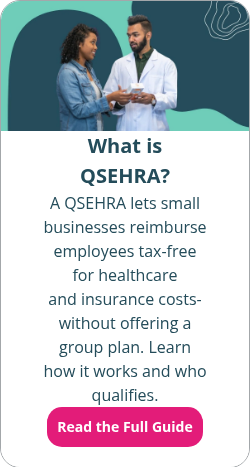Ten-step checklist for hiring your first employee for your small business
By Holly Bengfort on May 26, 2023 at 9:00 AM
Is your small business growing faster than you can handle? If so, it may be time to hire your first employee. This is an exciting milestone but one that comes with many regulations.
If you're new to the hiring process, finding your first employee can be daunting. But it doesn't have to be.
In this article, we'll go over ten steps on how to hire your first employee so you'll be ready to grow your business even further.
1. Get an employer identification number (EIN)
Before you can go hunting for your first employee, you'll need to register your organization with the IRS. This involves getting an employer identification number (EIN), also known as an employer tax ID, by filling out IRS Form SS-41.
Consider your EIN like a Social Security number for your business. You'll use your EIN on your tax forms, tax returns, and any other legal documents you submit to the IRS.
You probably already have an EIN if your organization is registered with your state. If not, be sure to get one (it's free and instantaneous) and take steps to register your business with your state.
2. Post your job ad and interview potential candidates
Once you have an EIN registered with the federal government and you’ve registered with your state as a legal business entity, you can begin the hiring process.
First, you'll want to post a job listing online so potential employees can find you. You can do this in many places, such as LinkedIn, Indeed, ZipRecruiter, and other job boards. You can also share that you're hiring on social media.
Make sure you choose a job description and title that fits the role. Your ad could also include salary, benefits, desired soft skills, and details about your company culture. Depending on where your business is located, you may be required to include compensation information.
States that require pay transparency as of 2023 include:
- California
- Colorado
- Connecticut
- Maryland
- Nevada
- New York
- Rhode Island
- Washington
Once you've attracted qualified candidates for the job, you can begin the interview process. You'll want to ask various interview questions to help narrow down your choice.
After you've found the ideal candidate, it's time to offer them the job!
3. Conduct a background check and other pre-employment screening
At this point in the hiring process, you may want to run a background check on your top candidate. This is your opportunity to make sure the person you're hiring is who they say they are. With a background check and other pre-employment screening methods, you can ensure the safety of yourself, your business, and your customers.
There are legal requirements for background checks. You should speak with a professional for legal advice and specific guidance.
4. Register with your state's employment agencies
Next, you'll need to register as an employer at the state level. This is mainly for tax purposes, so you can report and pay your income taxes if your state requires them2.
If your state has an income tax, you'll deduct those taxes from your employee's paycheck and then send the withheld taxes to your state's agency.
You'll also need to register your new employees with their state's new hire notification system. Registering with the state allows your state government to collect taxes and child support payments from your employees, if applicable.
All employers must report newly hired employees to a state directory within 20 days of their hire date. You can see the process for each state through the U.S. Department of Health and Human Services3.
5. Verify your new employee's eligibility to work in the U.S.
Once you're all registered at the federal and state level and have offered the job to your new employee, you'll need to verify their employment eligibility.
You can do this by having them fill out section one of the Employee Eligibility Verification Form4, also known as Form I-9. They'll also need to show you valid documentation with their ID and employment authorization, like a driver's license or Social Security card.
For most states, this is all you'll need to do to verify employees' eligibility. However, in some cases, you'll also need to enroll in the E-Verify program5. This usually only applies to larger employers, so you'll likely be all set after the I-9.
6. Get workers' compensation insurance
Next, depending on your state, you may be required to obtain worker's compensation insurance. This will protect you from workers who are injured or get sick due to workplace exposure.
You can get workers' compensation insurance coverage in a few ways:
- Through a commercial carrier
- On a self-insured basis
- Through your state's workers' compensation insurance program
7. Set up payroll
The next step is to set up a payroll method to ensure you're getting your new employee their paycheck regularly, as well as taking care of payroll taxes.
Most employers choose to do payroll through a payroll service provider. You'll want to choose one that covers everything from tracking your employee's hours, calculating tax withholdings for federal income tax and unemployment taxes, and sending checks. Depending on your state, you may also need to withhold state income tax.
Depending on the size of your business, things like taking care of payroll taxes and filings may only need to be completed monthly or quarterly.
When setting up payroll, you also need to consider the payment frequency for your employee. Will you pay them every two weeks, weekly, twice each month, or on a different system that meets federal and state wage laws?
8. Post workplace notices
As an employer, you're legally required to display posters in your office or workplace that educate your employees about their rights and your responsibilities under federal labor laws. You can get more details about which posters are required in your area from the U.S. Department of Labor6.
9. Ensure your employee is set up for success
Your work isn't done once you hire your first employee. You still need to set them up for success in their new role.
While you might not need to go into too much detail with your first employee, it's still a good idea to draft a short employee handbook that can be expanded upon as you grow your business. By having systems in place, you'll be able to grow your business much easier.
Take the time to properly train your new employee and share the goals for your organization so they know what they're working toward.
10. Plan to offer employee benefits
Finally, you'll want to make a plan for offering employee benefits to your new hire. Research from the Society for Human Resource Management7 has consistently found that the most requested employee benefit is health insurance or a similar health benefit.
As a small employer, you may not think you have the budget to offer a competitive benefits package. Thankfully, there are health benefits options available for small businesses.
One of the best ways to provide a health benefit to your first employee is to provide a health reimbursement arrangement (HRA). An HRA allows you to reimburse your employee for their qualifying medical expenses and individual health insurance premiums.
A qualified small employer HRA (QSEHRA), also known as the small business HRA, is specifically designed for organizations with fewer than 50 full-time equivalent employees (FTEs).
Through a QSEHRA, you set a monthly allowance for your employees to get reimbursed for their medical expenses. You only reimburse employees for the expenses they incur, so any unused funds at the end of the year stay with you.
An advantage to offering a QSEHRA is that it's tax-free for you. It’s also tax-free for your employees who have minimum essential coverage (MEC).
An alternative to an HRA is a taxable health stipend. This works similarly to an HRA, where you provide a monthly allowance for healthcare expenses. However, it has fewer regulations than an HRA, making it an excellent option for independent contractors and international employees. It may also be a good option for your organization if your new employee receives advance premium tax credits (APTC) from the federal government.
Other benefits you might consider as a small business include:
- Retirement plans, such as a 401(k)
- Wellness programs, such as a wellness stipend
- Remote work and flexible schedules
- Paid time off (PTO)
- Professional development and education benefits
- Commuter benefits
Conclusion
As you look forward to growing your small business with new employees, following these steps will get you started in the right direction. What's more, establishing an employee benefits plan now will set you apart from other small businesses that may not be investing in their employees' benefits, allowing you to recruit and retain top talent.
If you're ready to offer personalized health employee benefits that fit your budget, PeopleKeep can help! Our benefits administration software helps organizations like yours offer and manage HRAs in minutes each month.
This blog article was originally published on June 16, 2021. It was last updated on May 26, 2023.
- https://www.irs.gov/pub/irs-pdf/fss4.pdf
- https://www.thebalance.com/states-without-an-income-tax-3193345
- https://www.acf.hhs.gov/css/contact-information/state-new-hire-reporting-websites
- https://www.uscis.gov/sites/default/files/document/forms/i-9-paper-version.pdf
- https://www.e-verify.gov/
- https://www.dol.gov/general/topics/posters
- SHRM 2019 Healthcare and Health Services Trends
Check out more resources
See these related articles

What are boomerang employees?
Boomerang employees are individuals who return to work for a former employer after some time away. Learn about the benefits of hiring boomerang employees.

Reducing Employee Turnover - 12 Tips for Small Businesses
Reducing employee turnover. From hiring to retaining top talent. Check out these 12 tips for reducing employee turnover at small businesses.

What is a 1099 employee?
This article will explain what a 1099 employee is, how they differ from W-2 employees, and what rules you need to know when hiring a contractor.



